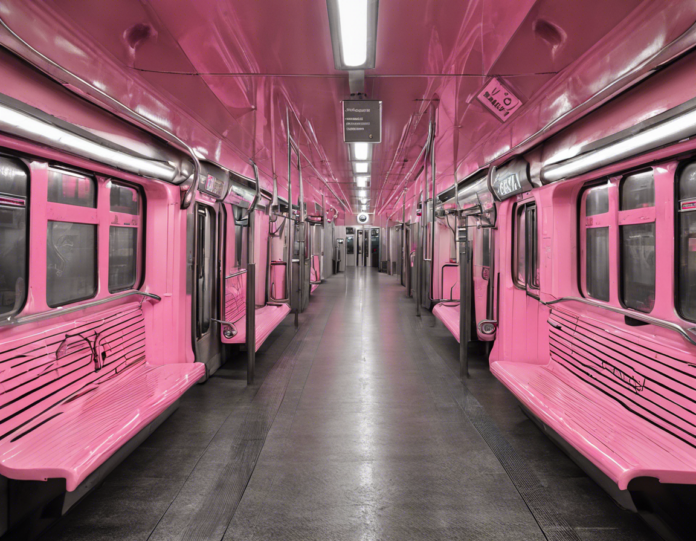Introduction
Delhi, the bustling capital city of India, is widely known for its historical monuments, diverse culture, and, of course, its congested roads. To alleviate the traffic woes and provide a convenient mode of transport to millions of commuters, the Delhi Metro Rail Corporation (DMRC) has been expanding its network since its inception in 2002. One of the newer additions to this network is the Pink Line.
What is the Pink Line?
The Pink Line is a part of the Delhi Metro network, officially known as Line 7, that snakes through the heart of Delhi, connecting major landmarks, residential areas, and commercial hubs. It is one of the newer corridors of the Delhi Metro, with the first section inaugurated in 2018. As of now, the entire Pink Line spans from Majlis Park in North Delhi to Shiv Vihar in East Delhi, covering a distance of around 59 kilometers.
Features of the Pink Line
The Pink Line is not just a mode of transport; it is a journey through Delhi’s vibrant tapestry. Here are some noteworthy features of this line:
1. Interchange Stations: The Pink Line intersects with several other lines of the Delhi Metro, including the Yellow Line, Blue Line, Violet Line, and Magenta Line. This interchange connectivity makes it easier for commuters to switch between different lines.
2. Convenient Connectivity: The Pink Line covers key areas in Delhi such as Durgabai Deshmukh South Campus, South Extension, INA, Lajpat Nagar, Mayur Vihar Phase-1, Anand Vihar ISBT, IP Extension, and more. It provides a vital link to various residential and commercial areas.
3. Aesthetic Stations: One of the hallmarks of the Pink Line is its aesthetically pleasing stations. You will find vibrant and artistic designs at stations like South Campus, Durgabai Deshmukh South Campus, Sarojini Nagar, Mayur Vihar Phase-1, and others.
4. Technology-driven: The Pink Line boasts modern amenities such as platform screen doors, barrier-free access for the differently-abled, high-speed elevators, and escalators. These technological advancements enhance the commuter experience.
5. Pink Line Extension: The Pink Line is continuously growing, with plans for further expansion to Majlis Park – Maujpur, enhancing connectivity for more areas in the city.
Benefits of Using the Pink Line
Commuting through Delhi can be a daunting task, especially during peak hours. The Pink Line offers several advantages that make it a preferred choice for many residents and visitors:
1. Time-saving: With dedicated tracks and minimal interference from road traffic, the Pink Line ensures a faster commute from one point to another.
2. Cost-effective: Opting for the Pink Line can help you save money on fuel and parking expenses, making it a budget-friendly mode of transport.
3. Environmental-friendly: By encouraging the use of public transport, the Pink Line plays a role in reducing carbon emissions and promoting a greener environment.
4. Comfort and Convenience: Air-conditioned coaches, designated seating for women and senior citizens, and real-time information displays add to the comfort and convenience of commuting via the Pink Line.
5. Reduced Traffic Congestion: Utilizing the Pink Line helps in decreasing traffic congestion on Delhi’s roads, contributing to a smoother traffic flow for all commuters.
Exploring Delhi Through the Pink Line
The Pink Line not only connects various parts of Delhi but also offers easy access to some iconic landmarks and hidden gems of the city. Here’s a curated list of places you can explore by hopping on the Pink Line:
1. Visit Dilli Haat, INA: A haven for art and craft enthusiasts, Dilli Haat is a bustling marketplace offering a variety of handlooms, handicrafts, and delectable cuisine from different states of India.
2. Experience the Chaos of Lajpat Nagar Market: Known for its affordable clothing, accessories, and footwear, Lajpat Nagar Market is a shopaholic’s paradise. Dive into the bustling lanes and grab some trendy finds.
3. Explore the Serene Lodhi Gardens: A peaceful retreat amidst the city’s chaos, Lodhi Gardens is a historical park dotted with tombs, lush greenery, and jogging tracks. Ideal for a leisurely stroll or a morning yoga session.
4. Indulge in Street Food at Mayur Vihar Phase-1: Satiate your taste buds with a variety of street food delicacies near the Mayur Vihar Phase-1 metro station. From chaats to parathas, this area is a food lover’s delight.
5. Marvel at the Lotus Temple: Get off at the Kalkaji Mandir metro station to visit the Lotus Temple, a stunning architectural marvel known for its flower-like shape and tranquil ambiance.
6. Witness Royalty at Raj Ghat: Pay homage to Mahatma Gandhi at Raj Ghat, located near the Daryaganj metro station. This serene memorial on the banks of the Yamuna River is a symbol of peace and simplicity.
7. Embrace the Spirituality at Akshardham: Hop off at the Akshardham metro station to explore the grandeur of the Akshardham Temple, showcasing Indian culture, spirituality, and architecture in all its glory.
Tips for Commuting on the Pink Line
While the Pink Line offers a seamless commute experience, here are some tips to enhance your journey:
1. Plan Your Travel: Use the official Delhi Metro Rail app or website to check the timings, routes, and station details before embarking on your journey.
2. Be Mindful of Peak Hours: To avoid the rush and ensure a comfortable journey, try to travel during non-peak hours if possible.
3. Use Smart Cards: Opt for a smart card for hassle-free entry and exit at stations. These rechargeable cards save time and eliminate the need for queuing at ticket counters.
4. Mind Your Belongings: Keep your belongings close and be vigilant, especially in crowded areas and during rush hours.
5. Follow Metro Etiquette: Maintain discipline while boarding and alighting from the train, offer seats to those in need, and refrain from littering inside the trains and stations.
Frequently Asked Questions (FAQs)
Q1. What is the frequency of trains on the Pink Line?
A1. Trains on the Pink Line usually operate at an interval of 4-6 minutes during peak hours and around 6-8 minutes during off-peak hours.
Q2. Are there any women’s special coaches on the Pink Line?
A2. Yes, the Pink Line, like other lines on the Delhi Metro, has designated women’s special coaches to ensure a safe and comfortable journey for female commuters.
Q3. Can I carry luggage while traveling on the Pink Line?
A3. Yes, passengers are allowed to carry luggage while traveling on the Pink Line; however, oversized or bulky luggage may not be permitted during peak hours.
Q4. Are there parking facilities available at Pink Line metro stations?
A4. Many Pink Line metro stations offer parking facilities for commuters, making it convenient for those who wish to drive to the stations.
Q5. Is the Pink Line accessible for differently-abled passengers?
A5. Yes, the Pink Line is equipped with ramp access, elevators, and designated spaces for differently-abled passengers to ensure a comfortable and inclusive commute experience.
Q6. Can I use the same token or card for interchange stations on the Pink Line?
A6. Yes, passengers can use the same token or card for interchange at designated stations on the Pink Line. There are specific guidelines for interchange, so it is advisable to follow them.
Q7. Does the Pink Line operate on Sundays and public holidays?
A7. Yes, the Pink Line operates on Sundays and public holidays, with timings adjusted according to the weekend schedule. It is advisable to check the official DMRC website for specific timings.
Q8. Are there any food or beverage outlets at Pink Line metro stations?
A8. Some Pink Line metro stations have food and beverage outlets within or in close proximity, allowing commuters to grab a quick bite or refreshment during their journey.
Q9. Can I recharge my metro card online for the Pink Line?
A9. Yes, commuters can easily recharge their metro cards online through the official Delhi Metro website or the DMRC app, ensuring a seamless travel experience on the Pink Line.
Q10. Are there any landmarks or tourist attractions near Pink Line stations that I can explore?
A10. Yes, the Pink Line is well-connected to various landmarks and tourist attractions in Delhi, such as markets, parks, historical sites, and religious places. Refer to the station guides available online for more information.
Conclusion
The Pink Line of the Delhi Metro stands as a lifeline for many residents and tourists, offering a convenient, efficient, and affordable mode of transportation through the bustling city of Delhi. Whether you are a daily commuter or an occasional traveler, exploring Delhi through the Pink Line unveils a plethora of experiences, from vibrant markets to historical monuments and cultural hotspots. Embrace the vibrancy of Delhi’s underground world, one Pink Line station at a time.


